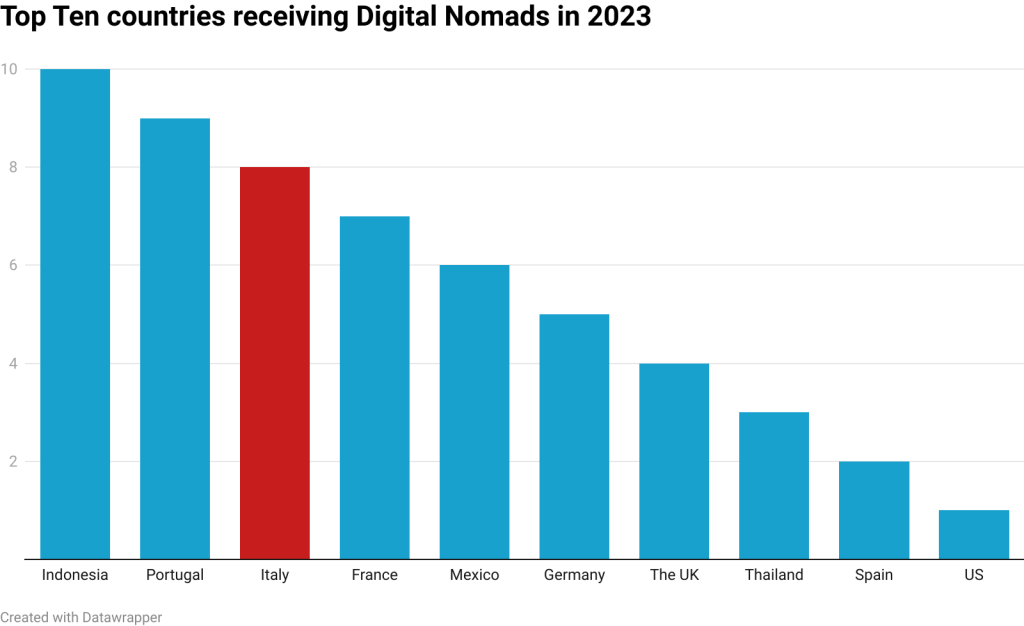Italy, the country most famous for its unique culture and hospitality, has been an alluring tourist destination for many travelers. For years, humans from all over the world are looking to spend their vacation experiencing Dolomite mountains and the new world of fashion in the North; cuisine and landmarks of Central Italy; or visiting and exploring charming coastlines and Islands of South of Italy. Nevertheless, new technological advancements have brought another wave of tourism to the country. Today, there is an influx of digital nomads that come to do remote work without taking up residency.
Clear overview of this phenomena asks for a definition of digital nomads. In simple words they are individuals who work remotely, in exchange to travel, explore and live in different places. The nomadic lifestyle has gained popularity during the last ten years but saw a growth spurt during and after the pandemic. Additional factors, such as loose economic regulation, cost of living disparity, except destination tempting places, have influenced nomads to travel to Italy. And guess what? Italy is in the top 10 destinations for digital nomads.

Close to half of all digital nomads that come to Italy are Americans. Jessica and Kyle, a South Carolinian married couple, are two of the many thousands that are living their nomadic dreams around the Mediterranean. It was only within the last year that they took up the nomadic lifestyle and traveled to Europe.

Jessica, a former teacher, and Kyle, who previously worked in a real estate company, seized the opportunity to start their own social media marketing firm after Covid-19. The shift not only allowed them to reinvent their professional lives, but also gave them the freedom to explore the world while working. Since September they have been traveling around Europe. One of their stops is based in Sorrento, Italy, a town in proximity to Naples, with only 16 thousand inhabitants.
Most nomads prefer even smaller towns, villages called borghi. They are often depicted by digital nomads as environments where one can engage directly with the local community and fully immerse oneself in social-cultural traditions that might be elusive in larger cities. And the foreign investment is invited, several municipalities have already done campaigns to attract internationals. One example that received much media attention was to offer old villas for a few dollars in exchange for commitments to renovations of the estates.
In the “Second Report on Digital Nomadism in Italy”, a survey carried out in March 2022, where more than 2000 digital nomads participated, data show interesting results.
Indeed, as it is possible to observe from the statistics, more nomads are more likely to be oriented to stay either in Southern regions/ Islands, where smaller towns and smaller communities are concentrated.
Antonio Cocerio, a minority counselor in Tiriolo, one of the small municipalities located in the southern part of Italy, highlighted that there is significant untapped potential for providing services to accommodate digital nomads. However, as of now, no initiatives have been undertaken to address this opportunity. Cocerio suggested that workspace related accommodation could be an effective measure to attract the nomads.

On the left Antonio Cocerio speaks at a conference, on the right the town of Tiriolo, attracting thousands of tourists every year.
However, anthropologist Dave Cook believes that an integration of digital nomads into the local culture might be wishful thinking. Having done years of studies on the phenomenon, Cook concludes that even though there is often a desire from the nomads to interact with local communities, villagers simply do not have that much interest.
“Locals in smaller towns often have a feeling about whether they’re going to get left or not. People locally know if newcomers are going to have some kind of permanence, if they’re going to stay rooted in a location”, says Cook, who explains that staying during a longer holiday, “even if it lasts several months, is still a short amount of time in terms of what happens in a local community”.
But even if the digital nomads care about adapting to the community, they have to overcome the linguistic barriers. Jessica and Kyle successfully communicated with locals on their travels through Italy, using Google Translate to round language barriers. Their exploration of the country took an unexpected turn when they discovered the affordability of the eastern coast of Italy, specifically in the Le Marche region. The housing cost through Airbnb for a month was a mere $700, breaking down to approximately $20 a day. The off-season nature of their stay meant fewer tourists, leading to reasonable prices at local establishments. This unexpected gem not only showcased Italy’s less-explored regions but also allowed the couple to integrate into the local community over a three-week period.
How long nomads tend to stay in the same location varies a great deal between demographics. Some jobs might demand that the person working stays in the same time zone, and factors such as the housing situation and climate might impact the length of the stay.
Beneath this idyllic portrait lies a significant challenge. In an interview with María Dolores Carrascosa Bermejo, an Associate Professor in the Faculty of Law (ICADE) specializing in Economic and Social Law at the University of Madrid, she delved into the complexities surrounding these issues.
“As the European Union, we don’t have a social security system, we don’t have specific rules, so we are applying the normal rules. And the normal rules (…) are not thought for virtual work. For this reason, we are not prepared to have a solution in these cases.”
In the context of small towns, the presence of digital nomads has the potential to reshape the local economy. The professor further emphasizes: “It could be great for the owner of the restaurant or the hotel, but for the normal citizens I don’t know if it is worth it. Sometimes it could be very complicated because everything could be expensive for the locals. And towns have no systems in place to think this through”.
Although the number of digital nomads has increased in the last few years, these towns may not be prepared for it. In fact, Italy is still undergoing the process of implementing new jurisdiction about visas. The visa for digital nomads in Italy was introduced in 2022, precisely through Decree-Law n. 4 of 27 January. This decree was converted into law in March, after undergoing some changes. For this reason, it is possible to stay in the country for an extended period compared to that provided by the classic tourist visa. However, it is not yet possible to apply for a visa, as the Ministry of the Interior has not issued specific rules for the application. In the meantime, however, the eligibility rules for visas and the criteria to be met to obtain them have been defined once the rules on the application procedures have been adopted.
In the rich mix of Italy’s culture and scenery, the wave of digital nomads adds a fresh and lively touch. From the ancient allure of Sorrento to the undiscovered treasures of Le Marche, individuals like Jessica and Kyle exploit the fusion of work and adventurous spirit. However, as the number of such individuals rises, Italy stands at the crossroads of redefining work regulations, and yet the absence of specific application rules signals uncertainty. In small towns, where economic boosts meet worries about locals affording things, the story gets trickier, making us wonder how Italy will juggle business chances and keep its unique vibe alive.
A prudent and impactful solution could involve channeling funds from the PNRR (National Recovery and Resilience Plan after the COVID-19 pandemic) into a comprehensive structural plan. Specifically, focusing on supporting and enhancing rural communities, the borghi, through targeted investments would not only accommodate the evolving needs of remote workers but also contribute to sustainable development in these regions.